A Wildlife Article used with permission from All-Creatures.org
In this informative article, illustrated with beautiful photographs taken by the author, Staci-lee Sherwood discusses the history of flamingos in the Americas, the threats faced by these birds around the world, and what we can do to help protect them.
Is the American Flamingo making a comeback in Florida?
From Staci-lee Sherwood, RealityChecksWithStacilee.com
September 2025
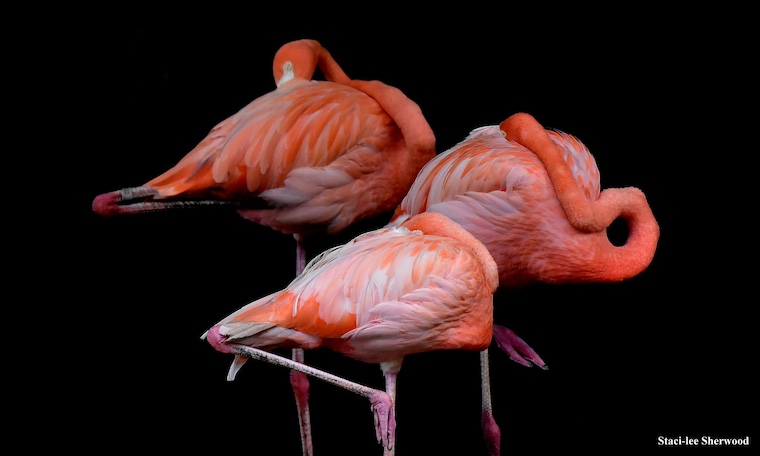
Photo Credit: Staci-lee Sherwood
If you ever get the chance to see flamingos in the wild it’s a sight worth the travel. A group of them is called a flamboyance and their striking color, size and striking features do make for a flamboyant and memorable sight. There are now just 6 distinct species of flamingos left in the world, prior to 1900 there were more than 22: American flamingo: (also known as the Caribbean flamingo), Andean flamingo, Chilean flamingo, Greater flamingo, James's flamingo: (also known as the Puna flamingo), Lesser flamingo. Not all flamingos are pink, some are more an orangey salmon like the American flamingo while others are pale and mostly white like the Greater flamingo. No matter what the color all flamingos are spectacular in their uniqueness. Food plays a role in their appearance, as in you are what you eat. Shrimp, with their rich salmon coloring, is a part of their diet but they also feast on other crustaceans, mollusks, insects and marine worms which all contribute to their array of pinks and orange.
History of flamingos in the Americas
Once abundant with numbers ranging from hundreds to thousands, they were often seen foraging for food in the south Florida wetlands by scientists and feather hunters prior to the early 1900s. The American flamingo hasn’t consistently been seen here since their population was decimated by the feather trade. Back then an ounce of feathers was worth more than an ounce of gold and used for hats, clothes and ornaments . In the Caribbean and Mexico flamingo populations are still sizable. While in some areas it may seem like they are flourishing overall their numbers have declined from what they were hundreds or thousands of years ago, their true historical population and range. There just isn’t enough clean water and pristine land left for what had been millions of flamingos living from the Americas to Africa. Over the years a sighting or two have occurred in Florida of flyovers or a few foraging for a couple of days, until recently.
It’s accepted by scientists the American flamingo population is about 150,000 ranging from Mexico and Cuba to the Caribbean and northern tip of South America. However like all estimates many are over estimations (in September 2025 the population of Africa’s Wildebeest was thought to be 1.3 million when it’s closer to 600,000) so one can never put too much faith in these numbers when accuracy is always a question. Another problem with reporting population of course is how to truly count moving animals.
I spoke with David Alonzo-Parra who works at FlamencoLab in the Yucatan, Mexico. He studies everything from flamingos to estuaries and shared many concerns about how scientific data is used. We talked about how the flamingos here in Florida might be doing and how observatory findings are sometimes ignored or the language altered to sound less damning or urgent. "Some technical reports produced by the management of protected natural areas are unreliable. Political factors are skewing the data and giving us a misleading idea of the actual condition of wild populations" Alonzo-Parra said. This is a huge issue many in the science community deal with when their discoveries of declining populations or degraded water and habitat are put aside or downplayed by those in charge of saving them. This is a global problem that can have a devastating effect on species in need of recovery from population decline.
A darker problem is the politics of hunting, conservation and economics. When these issues intersect estimations are usually placed higher to keep allowances for hunting and development which always take priority over conservation. A sad but true reality.
Click here to read how the feather trade nearly destroyed heron, egret, spoonbill and flamingo species none of which ever fully recovered.
https://www.realitycheckswithstacilee.com/post/a-feather-worth-more-than-gold-history-of-hunting-birds-for-the-feather-trade
Population decline around the world
Estimates for global populations vary by species and despite the accepted numbers ranging from approximately 60,000 (James’s flamingo) to 2 million (Lesser flamingo) on a global scale all species struggle as water levels rise, habitat is both lost and degraded, human harassment increases and lack of food have all contributed to population decline. Flamingos once had booming populations of millions until feather hunters killed them and modern energy sources like oil and coal caused an increase in global temperatures, leading to melting glaciers which caused rising oceans to wipe out some of their habitat. Extreme heat can cause eggs to boil while impacting how much food is living in the ocean. Flamingos breeding seasons are based on water levels and food availability.
Population decline is never about one cause but many that each exponentially make the others worse until the domino effect ends the species. Large animals need more food and space and tend to live longer. As their food supply dwindles and habitat shrinks the inevitable happens. Flamingos are large birds that stand several feet tall and nest in large flocks, so plentiful food and nesting grounds is a premium. Nesting on mudflats and saltpans means the nests are more prone to being flooded due to increased sea levels. Warmer oceans can mean less food which dictates the survival rate of chicks. A female lays just one egg, like penguins, so all their hope lies with just one chance their egg will hatch and their chick will grow strong enough to fledge. Even with a helpful mate survival depends on things out of their control.

A juvenile American Flamingo preening. Photo Credit: Staci-lee Sherwood
How do they fare in captivity
A flock of wild flamingos lives in a sanctuary in south Florida. Their home is a casino that has since closed down its racetrack. Though the flamingos are free to fly and breed they are fed by humans and their habitat is surrounded by condos, cars and trains. It’s noisy and polluted. Some have flown the coup but since none of these flamingos are banded or tracked it’s unknown where the escaped birds went, if they migrated back to another area or came back to the Florida racetrack sanctuary. They were brought here decades ago and have learned to stay because there is no open space nearby for them. Within the protected area there is little fear of predators. Despite flying over the racetrack during sunset, where they have an aerial view of their surroundings, they lack their wild instinct to migrate. Not all cages have bars.
Living in a zoo as one can imagine is worse. Birds that are not kept in cages have their wings clipped to prevent flight, many pet owners do the same with their birds. Flamingos are social birds so life in a zoo would be difficult unless their habitat was large enough to include fresh water and food with enough land for a sizable flock. Zoos today don’t offer anything near that so life for a flamingo stuck there is dreadful. Modern zoos may be ‘better’ than they were fifty years ago but that doesn’t raise the standard much. Life expectancy is about 10 years in the wild and that can be a long time with nowhere to go when you’re a migratory world traveler.
Captivity strips away every wild instinct and provides the same sterile environment day in and day out with no change of the menu. Most humans would hate that yet we don’t relay the same compassion to animals when we see them in a zoo. It’s time to rethink the need for zoos and watching the flamingos held there closely is a good place to start.
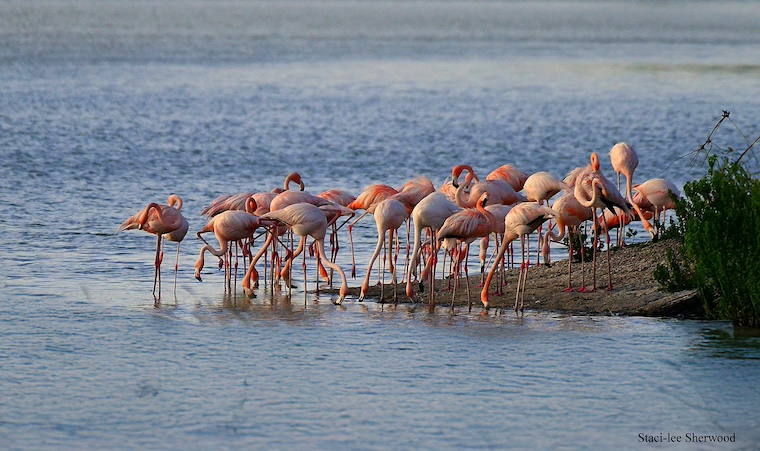
A free flock living in a human made sanctuary in Florida. Photo Credit: Staci-lee Sherwood
The wild isn’t so wild anymore
Even in a wildlife refuge there is always a trace of human encroachment. Once remote areas like the Arctic now show signs of human disturbance and trash left behind. Since 2023 a small group had been blown off course and landed in northern Florida. They have been living there ever since though haven’t had a breeding season. Their current residence is Merritt Island National Wildlife Refuge. The refuge allows fishing and hunting which begs the question what is the true point of a refuge if not full protection from any harassment from humans. As the human population continues to explode beyond capacity it will inevitably affect all other species in a negative way. There is only so much land and water available and for large birds in large flocks that doesn't bode well for the future if we continue to put our own species first instead of protecting the entire ecosystem for all species.
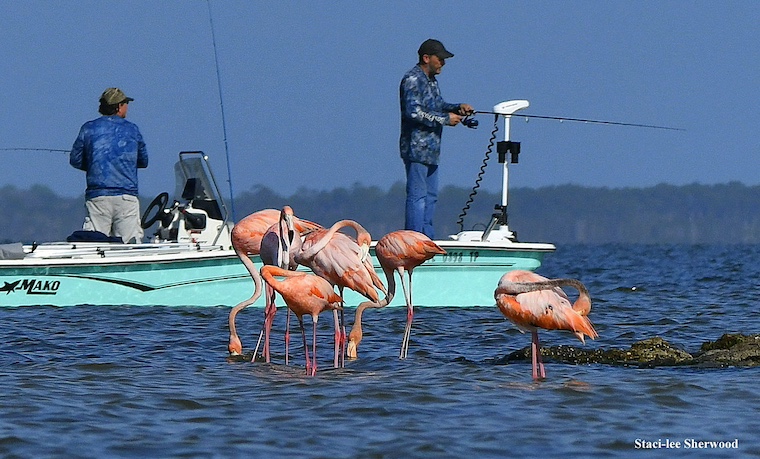
This is Merritt Island National Wildlife refuge in the spring of 2025. This boat is way too close but there is no one to enforce laws designed to protect wildlife from harassment, even a protected species. Photo Credit: Staci-lee Sherwood
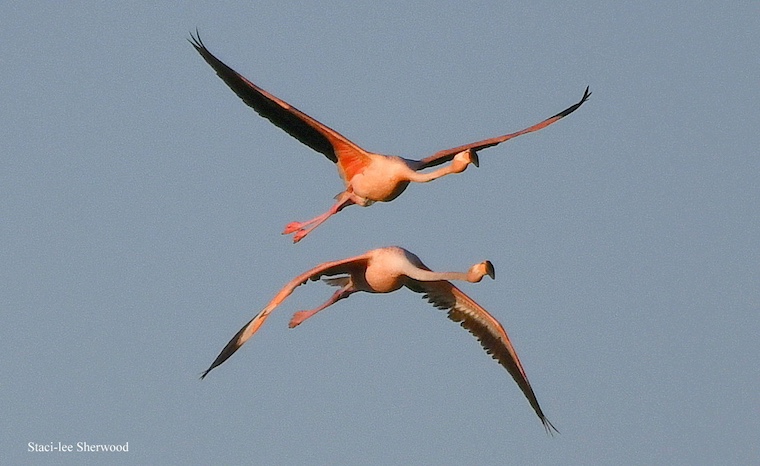
A pair of flamingos flies at sunset. Photo Credit: Staci-lee Sherwood
Ways to help save them
The first way would be to get involved with a nonprofit that genuinely is trying to save the species and their habitat. Focus on the flamingos whole ecosystem rather than just the species itself. Get involved with development projects regardless of how far away they seem and help to either stop, slow or shrink them because the planet is already over developed and non human species always take a back seat to human needs. Working to protect wetlands is vital not only for flamingos and other species but for we humans as well.
If you are lucky enough to see wild flamingos give them a lot of space. Getting too close forces them to abandon their nests and food and waste valuable energy eluding you when they could be using that to forage and rest. If you happen to see a band on a flamingo you can Google what the band looks like to find whatever group did the banding and contact them with date/time and location of your sighting. This helps keep track of migratory birds and their habitat and often helps protect a species.
In the spring of 2025 I got the chance to see a small flock that had arrived on the winds of a hurricane in 2023. They have made north Florida their home for two years but no one can predict if they will settle in and start a new colony or migrate. One of the flamingos was banded and after doing some research I found the group and got the background story. I sent a photo of adult flamingo DHDH to David Alonzo-Parra at FlamecoLab in Mexico and got this flamingo’s interesting life story back.
“The Story of DHDH
The name of our campaign to raise funds and continue the work of integrating, analyzing, and sharing information from banded flamingo tracking is: “Bands That Tell Stories.” And without a doubt, the story of the flamingo with band code DHDH is one of the most fascinating ones we have to share.
This flamingo was banded as a chick on September 7, 2014, in a place called Angostura, located within the Ría Lagartos Biosphere Reserve, on the eastern coast of the Yucatán Peninsula, Mexico. Angostura is a hypersaline wetland that, in some years, has faced challenges for nesting due to climate variability and the presence of feral dogs. Despite these threats, in 2014, an estimated 22,000 chicks hatched, of which 500 were banded, including DHDH.
This individual, born in Yucatán, was first recorded in Florida, USA, on September 2, 2023, and according to our database, remained in the region until its last sighting on April 23, 2025, (that would be my sighting) with no confirmed records of a return to Yucatán so far.
Between 2015 and 2024, we documented 1,417 banded flamingo records, allowing us to estimate that the average lifespan in the wild for flamingos born in Yucatán is 9.46 years. Our friend DHDH has been reported nine times, all in Florida, and at the time of the last sighting, was 11 years old—with the last two years spent in Florida’s wetlands, over 700 km away from its birthplace.
In general, it’s not unusual for flamingos born in Yucatán to be observed in other countries. A recent case is the one you mentioned, where six individuals were recorded in Florida following Hurricane Idalia, between September 1 and October 21, 2023. These flamingos were banded as chicks in Ría Lagartos 23, 21, 18, and 7 years ago, respectively. Their sudden reappearance after years without sightings raises some key questions:
- How long will they remain in Florida?
- Will they return to Yucatán?
- Will they move on to other countries?”
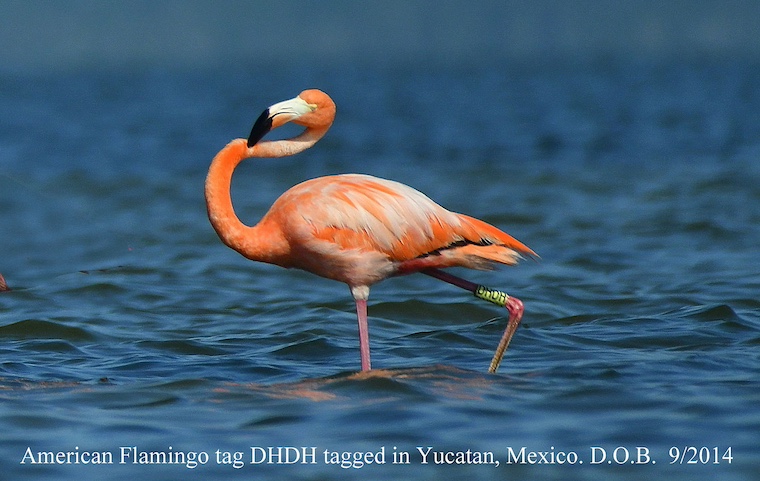
This is the tagged American Flamingo DHDH whose story is still unfinished. Photo Credit: Staci-lee Sherwood
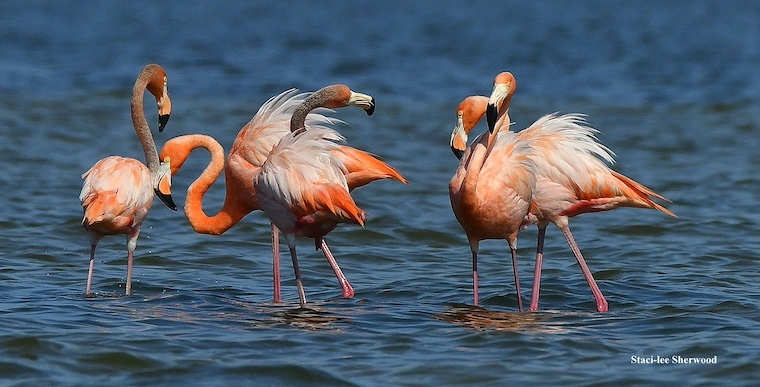
The rest of the flock…..for now. Photo Credit: Staci-lee Sherwood
Will DHDH and this small flock stay in the US and colonize or leave? Will the American Flamingo make a home here or remain a casual visitor? No one knows how this story will unfold but many are hoping for their permanent return. In June 2025 a flock of 122 flamingos were seen foraging in the Everglades, they only stayed a few days but give hope that someday flamingos will return home to Florida for good.
To report a tag seen on a flamingo click this link
https://www.flamencoyucatan.org/membres%C3%ADa
To learn more about American Flamingo click here
https://www.flamencoyucatan.org/
The Andean Flamingo Conservation monitors the rarest population, the Andean Flamingo which is endemic to the Andes Mountains, to see how mining effects them (central Andes are home to some of the largest lithium reserves on the planet and that probably spells disaster) Click here to learn more about this rare species
https://kentfarm.indiana.edu/research/flamingos.html
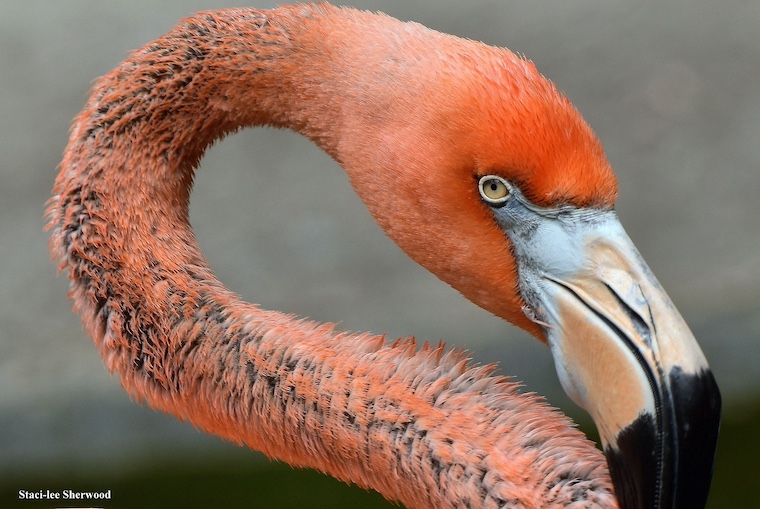
The face of the American Flamingo. Photo Credit: Staci-lee Sherwood
Posted on All-Creatures.org: October 30, 2025
Return to Wildlife Articles






